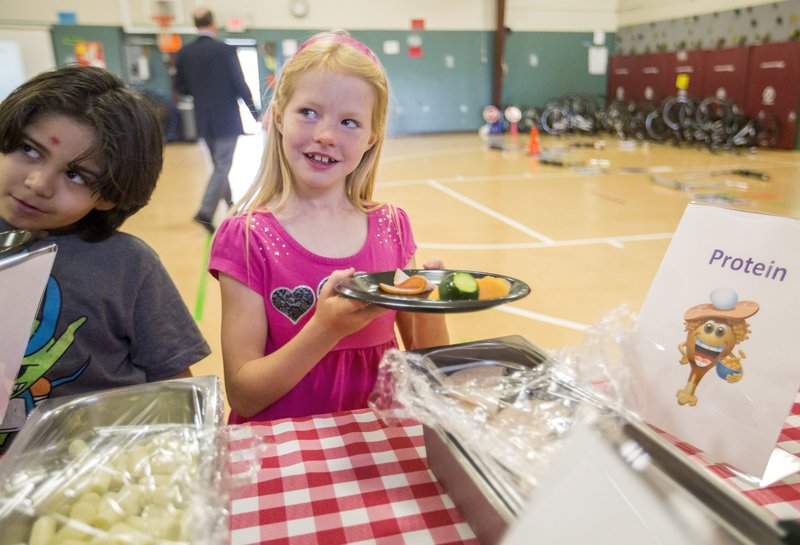FAYETTEVILLE -- Samantha Galindo, 8, arrived with a paper cutout of a soda to place on a poster-sized plate during a simulated "grocery shopping" relay in her physical education class, but the soda did not meet the nutrition requirements of a healthy plate.
She took off once more on a toy scooter to exchange the soda for a glass of milk to assist her team in filling the plate with components of all five food groups recommended by the U.S. Department of Agriculture as part of a healthy diet.
The game gave the children some exercise during a new health lesson developed by Ally Mrachek, a nutrition supervisor for Fayetteville Public Schools. She is testing the lesson with kindergarten through fifth-grade children at Asbell Elementary School. She taught the lesson for classes Wednesday and will teach them again today.
She developed the lesson after meeting with physical education teachers and previously tested it at Holcomb Elementary School.
"We believe that nutrition education should not only be in the cafeteria, but also in the classroom," Mrachek said.
The lesson will help physical education teachers in Fayetteville with teaching state health standards, said Cheyanne Plunkett, a physical education and health teacher at Asbell. Fayetteville lacks an elementary health curriculum, so physical education teachers search for resources to help them meet the health standards for each grade, she said.
Plunkett asked Mrachek for a lesson on MyPlate, a graphic illustration used by the U.S. Department of Agriculture in promotions for a healthy diet. The graphic divides a plate into four sections for protein, grain, fruits and vegetables and includes a glass for dairy.
The department encourages children to exercise and to choose nutritious foods as part of a healthy lifestyle.
The plan is to continue to develop health lessons and put them together in a binder for physical education teachers to use as a guide.
The new MyPlate lesson begins with a presentation on healthy meals, followed by a game. The youngest students play a "Fruit, Fruit, Veggie" a version of "Duck, Duck, Goose." Older students compete in the grocery shopping relay. The lesson concludes with a healthy snack party with tastes of all five food groups. On Wednesday, children ate pretzels for grains, string cheese for dairy, turkey for protein, cantaloupe for fruit and cucumbers for the vegetable.
Samantha said she sometimes has a hard time wanting to eat healthy foods but does like cucumbers.
"If my mom gives me cucumbers, I eat it because it's healthy," she said.
During the relay, six teams of three to four second-graders had a scooter on one end of the gym. They had to ride on the scooter across the gym to find paper cutouts of foods to make a healthy plate. Mrachek provided examples of healthy foods, but included some junk foods such as soda, chocolate and potato chips to test the children.
Each member of the team would bring back one food to put it in a labeled spot on a poster-sized paper cutout of a plate lying on the floor in front of their team. Second-grader Oliver Hodges' team retrieved strawberries for the fruit, green beans for the vegetable, oatmeal for the grain, yogurt for dairy and ham for protein.
Oliver, 7, said he likes steak as a protein, but also likes cooked ham.
"I try to save all my unhealthy food for dessert," he said.
For dessert, he likes small cakes topped with raspberries.
The lesson Wednesday included one bit of nutrition information he did not know -- that popcorn is a grain, he said.
Richard Hardwick, 8, assisted Mrachek during the demonstration. To demonstrate a balanced diet, Mrachek had Richard hold a plastic hanger with two strings attached to clips. She clipped paper cutouts of foods to the clips. At first, the foods were balanced on the hanger, but when she put a large waffle and too many grains on one side, the hanger dipped to that side. The pupils told her she needed more fruits, vegetables and protein to balance it.
"It was my first time holding a hanger like that," Richard said.
At home, Richard likes eating peanut butter and jelly sandwiches. For vegetables, he likes broccoli and mashed potatoes, he said. He said if children are reluctant to eat healthy, they should try something new.
Mrachek plans to share the lessons with all kindergarten through fifth-grade physical education teachers in the school district for use in the fall, but the lessons will be optional, she said.
NW News on 05/21/2015
